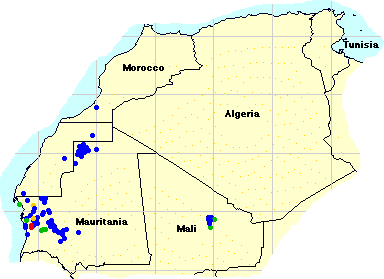6 December. Hopper band and swarm control in Mauritania
The current outbreak continues in central Mauritania where hopper bands and small newly forming swarms are being treated by ground teams between Tidjikja, Boutilimit and Akjoujt. Another generation of breeding has occurred in this area. Small swarms are expected to move from here to northern Mauritania and southern Morocco in the coming weeks. Breeding may occur before the end of the year in these areas where rain falls. Infestations declined in northern Mali where only insignificant numbers remain. On the coastal plains of both sides of the Red Sea, locust numbers will increase in areas where good rains have fallen for the second consecutive month. So far, only low numbers are reported from Sudan but may be present in Saudi Arabia, Yemen and Eritrea. Elsewhere, isolated adults are present in southern Egypt and in northern Somalia.
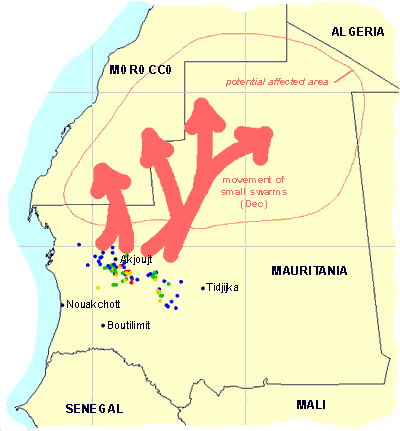
9 November. Hopper bands in Mauritania and northern Mali
A small outbreak has developed in central Mauritania where above-average rains fell and hoppers have started to form a few small bands. A similar outbreak may be in progress in northern Mali. During the forecast period, groups and perhaps a few small swarms could form in both countries. Those in northern Mali are likely to move towards southern Algeria and northern Mauritania. Elsewhere, small scale breeding occurred in central Sudan and isolated adults were present on the Red Sea coast of Yemen, in north-western Somalia and along the Indo-Pakistan border. During the forecast period, low numbers of adults are likely to appear on the Red Sea coastal plains where conditions are already favourable for breeding.
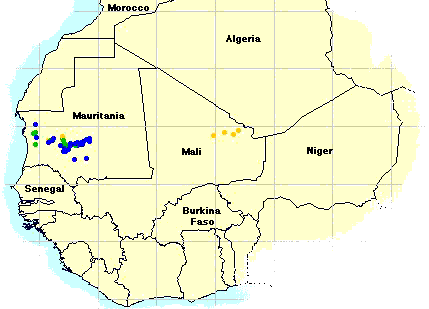
10 October. New reports of a few swarms and some hopper bands in N. Mali
New reports received from Mali since the issue of the last FAO Desert Locust Bulletin (No. 264 on 4 October) indicate that a few bands and swarms are present in the north. Some of these could move into adjacent areas of southern Algeria and northern Mauritania in November. Those countries and their Commission are urged to undertake regular surveys and keep FAO informed. At this point, other regions are not affected.
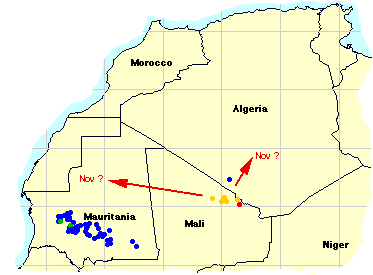
5 October. Calm situation prevails
Despite good rainfall and favourable breeding conditions in several summer breeding areas of West Africa, the Desert Locust situation continued to remain calm during September. Only low numbers of solitarious adults and small scale breeding were reported in Mauritania. Isolated adults were present in northern Somalia and along the Indo-Pakistan border. More than 3000 ha of adult and hopper groups were treated in a few oases in southern Egypt. During the forecast period, vegetation will start to dry up and, in a few places, adults could become concentrated as they start to shift from summer to winter breeding areas. This movement is expected to be on a very small scale this year.
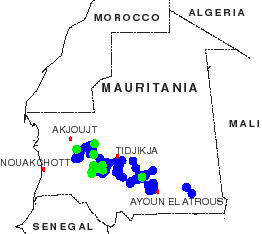
5 September. Situation continues to remain calm despite good breeding conditions
Although conditions are favourable for breeding in many parts of the northern Sahel in Africa and along the Indo-Pakistan border, no significant Desert Locust infestations have been reported to date and only small scale breeding is in progress in southern Mauritania. Low numbers of solitary adults are present along the Indo-Pakistan border, in northern Somalia and in central Niger. Breeding on a small and non-threatening scale may occur in parts of these areas as well as in northern Mali and Sudan in the coming weeks. In Morocco, limited control operations were carried out against hopper and fledgling groups in early August.
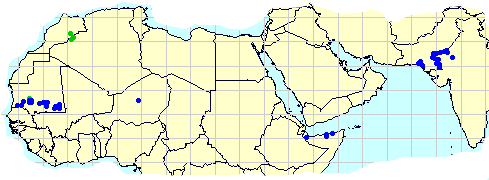
In Morocco, limited control operations were carried out against hopper and fledgling groups. Low numbers of adults are present in a few places of south-eastern Algeria, southern Mauritania, central Sudan, northern Somalia and along the Indo-Pakistan border. Except for Algeria and Morocco, breeding conditions are favourable in most of these areas and small scale laying could occur during the coming weeks.
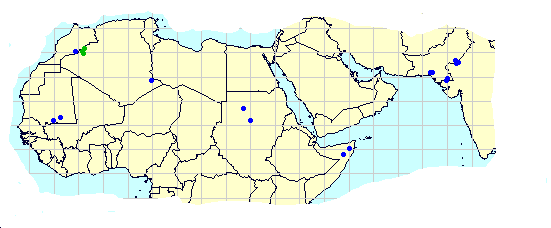
5 July. Calm situation continues
Only a few insignificant adults were reported in north-western Mauritania, in central Niger, south-eastern Morocco, Egypt and northern Somalia. Breeding conditions are currently improving in the northern Sahel from Mali to Sudan where small scale laying may occur during the coming weeks.
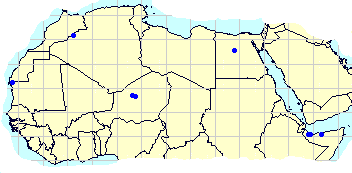
8 June. Situation returns to calm in all areas
Only insignificant and isolated populations of Desert Locust are reported to present in a few places of northern Somalia and western Pakistan. Early rains have fallen in the interior of Sudan and in southern Algeria. Isolated reports of a small group of locusts in central Mauritania and some in southwestern Morocco suggest that adults are moving from spring breeding areas of northern Mauritania towards the summer breeding areas of southern Mauritania. No significant developments are expected in the coming weeks.
16 May. Situation improves in N. Mauritania but control continues on Algerian-Libyan border
Ground control operations against hopper bands have finished in northern Mauritania where only low numbers of locusts persist. As vegetation continues to dry out, these will move to the summer breeding areas of southern Mauritania. Control is in progress against small infestations of hopper bands in south-eastern Algeria and adjacent areas of south-western Libya. There are no reports of significant activity in other countries due to dry and unfavourable breeding conditions.
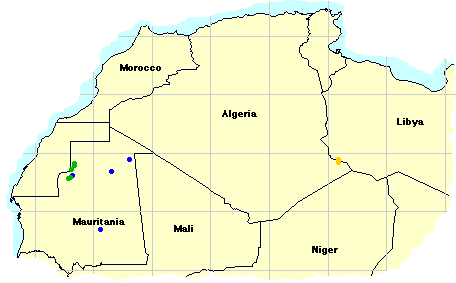
4 April. Hopper bands in N. Mauritania
Ground control operations have stepped up in the extreme north of Mauritania where more hopper bands have been found from previous breeding near Bir Moghrein. Small swarms could form by the end of the month. Laying by high densities of adults has been detected on the Algerian-Libyan border. Hatching and band formation are likely to occur in the coming weeks. Elsewhere, unusually dry conditions prevail and the locust situation remains calm.
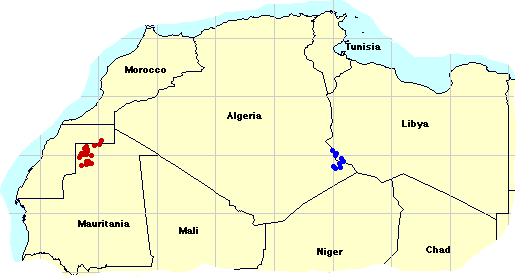
10 March. Breeding and control in N. Mauritania
Although small scale control operations are in progress against groups of adults in the extreme north of Mauritania, they could not prevent egg-laying which started during the last week of February. The situation is being carefully monitored and hatching should start in mid March. Isolated adults are present in Niger. Unfavourable breeding conditions prevail along both sides of the Red Sea except for one area on the southern coast of Sudan where small scale breeding is in progress. Elsewhere, the situation remains calm.
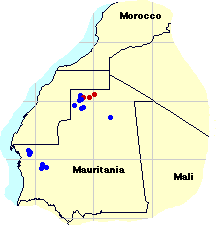
23 February. Calm situation prevails
Low numbers of locust adults continue to be scattered throughout the extreme north of Mauritania. Some of these were seen copulating and small scale hatching is expected by the end of the month. Breeding conditions are becoming unfavourable along both sides of the Red Sea as vegetation dries out in the absence of recent rainfall. Consequently no significant developments are likely. Elsewhere, the situation remains calm.
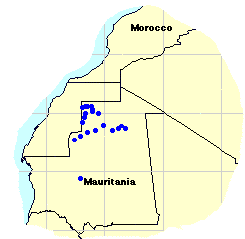
9 February. Improving situation in northern Mauritania being closely monitored
Locust adults are scattered throughout the extreme north of Mauritania as a result of breeding from a recent outbreak further south near Nouakchott. At the moment the situation is not threatening but it is being closely monitored by national teams. There is no indication that it has spread into neighbouring Algeria and Morocco. In the Red Sea winter breeding areas, small scale breeding has so far only been detected on the coastal plains of Sudan. Elsewhere, the situation is calm.
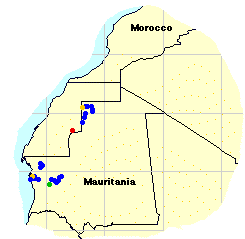
11 January. Outbreak ends in Mali but a second one is in progress in Mauritania
The outbreak in northern Mali is coming to an end as a result of control operations and migration of adults. However, another outbreak has developed in northern Mauritania where control operations are in progress. There is a possibility that current infestations will extend into neighbouring areas of southern Morocco and western Algeria. On the Red Sea coasts, small scale breeding is thought to have commenced in a few places in Sudan, Egypt, Eritrea, Saudi Arabia and Yemen. Elsewhere, the situation is calm.
